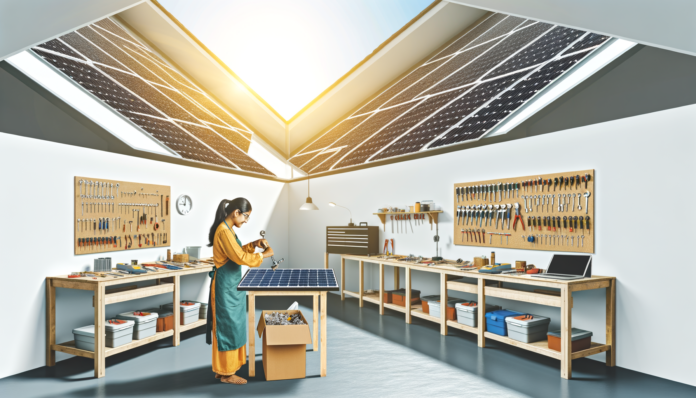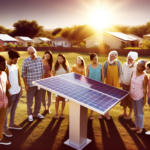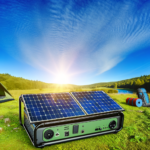Introduction
The Growing Appeal of Solar Power
In recent years, solar power has surged in popularity, becoming a cornerstone of sustainable living and renewable energy solutions. The appeal of solar power lies in its ability to harness the sun’s energy, a free and abundant resource, to generate electricity. This not only reduces reliance on fossil fuels but also minimizes environmental impact. As technology advances, solar panels have become more efficient and affordable, making them accessible to a broader audience. From residential rooftops to large-scale solar farms, the adoption of solar energy is a testament to its growing appeal and the global shift towards greener energy solutions.
Why a Solar-Powered Workshop?
Creating a solar-powered workshop is an excellent way to combine passion with sustainability. Whether you’re an artist, designer, educator, or hobbyist, a solar-powered workshop offers numerous benefits. Firstly, it provides a reliable and independent power source, ensuring that your projects are not interrupted by power outages. Secondly, it significantly reduces electricity costs, allowing you to invest more in your craft. Additionally, a solar-powered workshop aligns with eco-friendly practices, reducing your carbon footprint and promoting environmental stewardship. By powering your workshop with solar energy, you not only support your creative endeavors but also contribute to a sustainable future.
Overview of the Article
This article will guide you through the process of creating a solar-powered workshop, from understanding the basics of solar power to optimizing your setup for maximum efficiency. We will start with an introduction to solar power, including how solar panels work and the different types available. Next, we will delve into planning your solar-powered workshop, covering essential aspects such as assessing your power needs, choosing the right location, and budgeting for your solar setup. Following this, we will provide detailed instructions on setting up your solar power system, including installing solar panels, connecting batteries and inverters, and ensuring wiring and safety considerations.
Once your system is up and running, we will discuss ways to optimize your workshop, such as using energy-efficient tools, maximizing sunlight exposure, and maintaining your solar power system. Finally, we will explore the benefits of a solar-powered workshop, highlighting the environmental impact, cost savings, and the independence and reliability it offers. By the end of this article, you will have a comprehensive understanding of how to power your passion sustainably and efficiently with solar energy.
Understanding Solar Power Basics
How Solar Panels Work
Solar panels, also known as photovoltaic (PV) panels, convert sunlight directly into electricity. This process occurs through the photovoltaic effect, where light photons knock electrons loose from atoms within the solar cells, creating a flow of electricity. Each solar cell is made of semiconductor materials, typically silicon, which are specially treated to form an electric field. When sunlight hits the cells, the electric field pushes the freed electrons, generating a direct current (DC) of electricity. This DC electricity can then be used immediately, stored in batteries, or converted to alternating current (AC) using an inverter for use in standard electrical devices.
Types of Solar Panels
There are several types of solar panels available, each with its own advantages and disadvantages:
- Monocrystalline Solar Panels: Made from a single continuous crystal structure, these panels are known for their high efficiency and longevity. They are typically more expensive but offer the best performance in terms of space efficiency and energy output.
- Polycrystalline Solar Panels: These panels are made from multiple silicon crystals melted together. They are less efficient than monocrystalline panels but are more affordable, making them a popular choice for residential installations.
- Thin-Film Solar Panels: Composed of layers of photovoltaic material on a substrate, thin-film panels are lightweight and flexible. They are less efficient and have a shorter lifespan compared to crystalline panels but are useful for specific applications where flexibility and weight are critical.
Key Components of a Solar Power System
A solar power system consists of several key components that work together to generate, store, and distribute electricity:
- Solar Panels: The primary component that captures sunlight and converts it into electricity.
- Inverter: Converts the DC electricity produced by the solar panels into AC electricity, which is used by most household appliances and can be fed into the electrical grid.
- Batteries: Store excess electricity generated by the solar panels for use when sunlight is not available, such as during the night or on cloudy days.
- Charge Controller: Regulates the voltage and current coming from the solar panels to the batteries, preventing overcharging and extending battery life.
- Mounting System: Secures the solar panels to the roof or ground, ensuring they are positioned at the optimal angle to capture maximum sunlight.
- Monitoring System: Tracks the performance of the solar power system, providing data on energy production and usage, which helps in optimizing efficiency and identifying any issues.
Understanding these basics is crucial for anyone looking to set up a solar-powered workshop. By knowing how solar panels work, the types available, and the key components of a solar power system, you can make informed decisions that will help you harness the power of the sun effectively and efficiently.
Planning Your Solar-Powered Workshop
Assessing Your Power Needs
Before diving into the setup of your solar-powered workshop, it’s crucial to understand your power requirements. Start by listing all the tools and equipment you plan to use. Consider their wattage and how long you typically use each item. For instance, a table saw might use 1,500 watts, while a power drill might use 600 watts.
To calculate your total power needs, use the formula:
Total Power (Watt-hours) = Power (Watts) x Usage Time (Hours).
For example, if you use a 1,500-watt table saw for 2 hours a day, it will consume 3,000 watt-hours (or 3 kWh) daily. Sum up the watt-hours for all your tools to get a comprehensive view of your daily power consumption. This will help you determine the size and number of solar panels, batteries, and other components you’ll need.
Choosing the Right Location
The location of your workshop plays a pivotal role in the efficiency of your solar power system. Here are some key factors to consider:
- Sunlight Exposure: Choose a spot that receives direct sunlight for most of the day. Use tools like sun calculators or apps to track the sun’s path and ensure optimal exposure.
- Avoid Obstructions: Ensure there are no tall buildings, trees, or other structures casting shadows on your solar panels, especially during peak sunlight hours.
- Accessibility: Your workshop should be easily accessible from your home or main building, especially if you frequently move heavy equipment in and out. Also, consider the ease of maintenance and potential future expansions.
Budgeting for Your Solar Setup
Creating a budget is a critical step in planning your solar-powered workshop. While the initial investment can be substantial, the long-term savings and environmental benefits are significant. Here’s a breakdown of potential costs:
- Solar Panels: The cost varies based on the type and efficiency. Monocrystalline panels are more efficient but pricier, while polycrystalline panels are more affordable but slightly less efficient.
- Inverters: String inverters are cheaper but less efficient if one panel underperforms. Microinverters, though more expensive, optimize each panel’s output, making them ideal for partially shaded areas.
- Batteries: Lithium-ion batteries are popular for their long lifespan and efficient power storage. Consider the capacity, depth of discharge (DoD), and lifespan when choosing batteries.
- Installation and Labor: Professional installation ensures safety and efficiency but comes at a cost. DIY installation can save money but requires a good understanding of electrical systems.
- Miscellaneous Costs: Include expenses for wiring, mounting systems, permits, and any additional tools or equipment. Always set aside a contingency fund of 10-15% for unexpected expenses.
By carefully assessing your power needs, choosing the optimal location, and budgeting effectively, you’ll be well on your way to creating a functional and efficient solar-powered workshop. This planning phase is crucial for ensuring that your workshop not only meets your current needs but is also scalable for future expansions.
Setting Up Your Solar Power System
Installing Solar Panels
Installing solar panels is the most exciting step in setting up your solar-powered workshop. Here’s a step-by-step guide to ensure you get it right:
1. **Mounting System**: Invest in a sturdy racking system. Given that it bears the weight of the panels, often for decades, skimping here can be a costly mistake. There are fixed mounts, but adjustable mounts allow changing the panel’s inclination based on the season, optimizing energy capture.
2. **Panel Direction**: The general thumb rule is:
– **Northern Hemisphere**: Panels should predominantly face south to capture the maximum sunlight.
– **Southern Hemisphere**: Aim for a northern orientation.
3. **Angle of Inclination**: The tilt angle is crucial. It should ideally equal your latitude, but slight adjustments can be made seasonally for better efficiency. During winter, a steeper angle helps capture the lower sun, while in summer, a flatter angle is beneficial.
4. **Securing Panels**: Once the mounts are in place, secure the panels using the provided hardware. Ensure all bolts and screws are tightly fastened to withstand wind and other environmental factors.
Connecting Batteries and Inverters
After installing the solar panels, the next step is to connect the batteries and inverters, which are essential for storing and converting the solar energy.
1. **Battery Storage**:
– **Location**: Place your batteries in a cool, dry, and well-ventilated area. Excessive heat can reduce battery life and efficiency.
– **Protection**: Shield the batteries from direct sunlight. A consistent temperature helps in maintaining optimal battery performance.
2. **Connecting Batteries**:
– **Series vs. Parallel**: Decide whether to connect your batteries in series (increases voltage) or parallel (increases capacity). This depends on your power needs and the specifications of your inverter.
– **Wiring**: Use high-quality, UV-resistant wires for connections. Properly insulating them prevents potential shorts and reduces the risk of fires.
3. **Inverter Setup**:
– **Location**: Your inverter should be placed in a cool, dry spot. Overheating reduces efficiency and can even damage the inverter. While garages or basements are commonly chosen, ensure the place is free from excessive dust or moisture.
– **Connection**: Connect the inverter to the battery bank and then to the main electrical panel of your workshop. Follow the manufacturer’s instructions carefully to ensure a safe and efficient setup.
Wiring and Safety Considerations
Proper wiring and safety measures are crucial to ensure the longevity and efficiency of your solar power system.
1. **Wiring**:
– **Quality**: Opt for high-quality, UV-resistant wires, especially for connections outside the workshop. Properly insulating them prevents potential shorts and reduces the risk of fires.
– **Routing**: Plan the routing of wires to avoid physical damage and minimize exposure to the elements. Use conduit pipes where necessary to protect the wires.
2. **Safety Considerations**:
– **Circuit Breakers and Fuses**: Install appropriate circuit breakers and fuses to protect your system from overloads and short circuits.
– **Grounding**: Properly ground your solar power system to prevent electrical shocks and ensure safety during maintenance.
– **Labels and Signage**: Clearly label all components and connections. This is crucial for maintenance and in case of emergencies.
– **Regular Inspections**: Periodically inspect your system for any signs of wear and tear, loose connections, or other potential issues. Regular maintenance ensures the system operates efficiently and safely.
By following these detailed steps and taking into consideration each aspect carefully, you’ll be well on your way to creating an efficient, productive, and sustainable solar workshop.
Optimizing Your Solar Workshop
Energy-Efficient Tools and Equipment
To truly harness the benefits of a solar-powered workshop, integrating energy-efficient tools and equipment is paramount. **Energy-efficient tools** not only save power but also put less strain on your solar system, allowing for prolonged usage. For instance, tools with **brushless motors** are known for better efficiency and longer lifespan compared to their brushed counterparts.
**LED lighting** is another crucial component. LEDs consume significantly less electricity compared to traditional bulbs and provide better luminosity. Their longevity ensures you won’t be changing them out frequently, which is both cost-effective and convenient.
When it comes to appliances like fans, heaters, or even a mini-fridge, ensure they are rated high for energy efficiency. This can be a game-changer in maintaining a steady power balance. Look for appliances with the **Energy Star** label, which signifies they meet strict energy efficiency guidelines set by the U.S. Environmental Protection Agency.
Maximizing Sunlight Exposure
Maximizing sunlight exposure is critical for the efficiency of your solar power system. The location of your solar panels should be free from obstructions like tall buildings, trees, or other structures that could cast shadows, especially during peak sunlight hours.
**Panel Direction and Angle**: In the Northern Hemisphere, panels should predominantly face south to capture the maximum sunlight. Conversely, in the Southern Hemisphere, aim for a northern orientation. The tilt angle of your panels should ideally equal your latitude, but slight adjustments can be made seasonally for better efficiency. During winter, a steeper angle helps capture the lower sun, while in summer, a flatter angle is beneficial.
**Adjustable Mounts**: Investing in adjustable mounts allows you to change the panel’s inclination based on the season, optimizing energy capture. This flexibility can significantly enhance the overall efficiency of your solar power system.
Monitoring and Maintenance
Regular monitoring and maintenance are essential to ensure your solar workshop operates at peak efficiency.
**Monitoring Systems**: Install a monitoring system to keep track of your solar power generation and consumption. These systems can provide real-time data and alerts if something goes wrong. Many modern inverters come with built-in monitoring capabilities that can be accessed via a smartphone app or a web portal.
**Routine Inspections**: Conduct routine inspections of your solar panels and other components. Look for any signs of damage, dirt, or debris that could affect performance. Cleaning the panels periodically to remove dust, leaves, or bird droppings can significantly improve their efficiency.
**Battery Maintenance**: If your system includes batteries, ensure they are well-maintained. Check the electrolyte levels in lead-acid batteries and ensure they are properly ventilated. For lithium-ion batteries, ensure they are kept at optimal temperatures and check for any software updates that might improve performance.
**Professional Check-ups**: Schedule professional check-ups at least once a year. A qualified technician can perform a thorough inspection and maintenance routine, ensuring all components are in good working order and addressing any potential issues before they become significant problems.
By focusing on energy-efficient tools, maximizing sunlight exposure, and maintaining a robust monitoring and maintenance routine, you can optimize your solar-powered workshop for maximum efficiency and longevity.
Benefits of a Solar-Powered Workshop
Environmental Impact
One of the most compelling reasons to create a solar-powered workshop is its positive environmental impact. Solar energy is a clean, renewable resource that significantly reduces greenhouse gas emissions compared to traditional fossil fuels. By harnessing the power of the sun, you can minimize your carbon footprint and contribute to the fight against climate change.
Moreover, solar panels have a long lifespan, often exceeding 25 years, which means they provide a sustainable energy solution for decades. This longevity reduces the need for frequent replacements and the associated environmental costs of manufacturing and disposing of energy equipment. Additionally, solar power systems require minimal maintenance, further reducing their environmental impact over time.
Cost Savings
While the initial investment in a solar power system can be substantial, the long-term cost savings are significant. Once installed, solar panels generate electricity at no additional cost, allowing you to reduce or even eliminate your monthly energy bills. Over time, these savings can offset the initial installation costs, making solar power a financially sound investment.
Furthermore, many regions offer incentives, rebates, and tax credits for installing solar power systems, which can substantially lower the upfront costs. By taking advantage of these financial incentives, you can make your solar-powered workshop even more cost-effective. Additionally, as energy prices continue to rise, having a solar power system insulates you from future increases in electricity costs, providing long-term financial stability.
Independence and Reliability
A solar-powered workshop offers a level of independence and reliability that is hard to match with traditional energy sources. By generating your own electricity, you become less reliant on the grid and less vulnerable to power outages. This is particularly beneficial for workshops located in remote areas or regions prone to frequent power disruptions.
Moreover, solar power systems can be paired with battery storage solutions, allowing you to store excess energy generated during sunny periods for use during cloudy days or at night. This ensures a consistent and reliable power supply, enabling you to work uninterrupted regardless of external conditions.
In addition to energy independence, a solar-powered workshop can also enhance your self-sufficiency and resilience. By producing your own energy, you are less affected by geopolitical events, natural disasters, or other factors that can disrupt traditional energy supplies. This reliability is invaluable for maintaining productivity and peace of mind.
In summary, a solar-powered workshop offers numerous benefits, including a reduced environmental impact, significant cost savings, and enhanced independence and reliability. By investing in solar power, you not only contribute to a more sustainable future but also create a more efficient and resilient workspace.
Conclusion
Recap of Key Points
As we conclude our journey into creating a solar-powered workshop, let’s revisit the essential steps and considerations that will guide you toward a sustainable and efficient workspace. We began by understanding the growing appeal of solar power and its relevance in today’s world. We then delved into the basics of solar power, exploring how solar panels work, the different types available, and the key components of a solar power system.
Planning your solar-powered workshop involved assessing your power needs, choosing the right location, and budgeting for your setup. Setting up the system required careful installation of solar panels, connecting batteries and inverters, and ensuring proper wiring and safety measures. To optimize your workshop, we discussed the importance of energy-efficient tools, maximizing sunlight exposure, and regular monitoring and maintenance. Finally, we highlighted the numerous benefits of a solar-powered workshop, including its positive environmental impact, cost savings, and the independence and reliability it offers.
Encouragement to Start Your Solar Journey
Embarking on the journey to create a solar-powered workshop is not just a step towards sustainability; it’s a commitment to innovation and self-reliance. The process may seem daunting at first, but with careful planning and execution, the rewards are immense. Imagine a workspace where you harness the power of the sun to fuel your creativity and productivity, all while reducing your carbon footprint and energy costs.
Your solar-powered workshop will stand as a testament to your dedication to environmental stewardship and your willingness to embrace new technologies. Whether you’re a DIY enthusiast, a professional craftsman, or someone passionate about sustainability, this project is a significant stride towards a greener future. So, take that first step, gather your resources, and let the sun power your passion.
Additional Resources and Next Steps
To assist you further on your solar journey, here are some additional resources and next steps:
- Online Courses and Tutorials: Websites like Coursera, Udemy, and Khan Academy offer comprehensive courses on solar power and renewable energy systems.
- Books and Guides: Consider reading books such as “Solar Power for Dummies” by Rik DeGunther or “The Solar Electricity Handbook” by Michael Boxwell for in-depth knowledge.
- Local Workshops and Seminars: Check for local workshops or seminars on solar energy. These can provide hands-on experience and networking opportunities with like-minded individuals.
- Government and NGO Programs: Look into government incentives, grants, and programs that support solar energy projects. Organizations like the Solar Energy Industries Association (SEIA) and local environmental NGOs can also be valuable resources.
- Professional Consultation: If you feel overwhelmed, consider consulting with a professional solar installer or an energy consultant to guide you through the process.
By leveraging these resources, you can gain the knowledge and confidence needed to successfully implement your solar-powered workshop. Remember, every small step towards sustainability makes a significant impact. So, equip yourself with the right tools and information, and let your solar journey begin.






